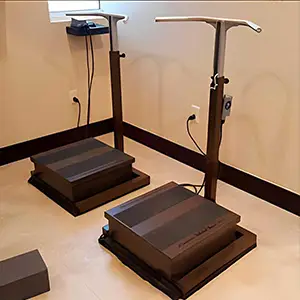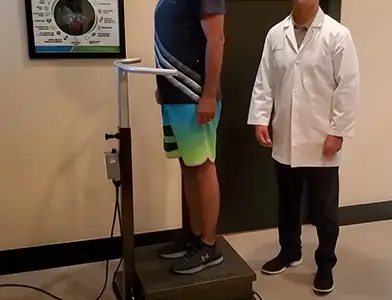The Vibe Neuropathy Vibration Therapy Effective Pain Relief and Improved Quality of Life
The vibes specific vibrational frequency stimulates and promotes the healing of damaged soft and hard tissues. The vibration therapy increases circulation, stimulates damage nerve fibers, improves flexibility, increasing muscle strength, improves bone density, and stimulates the lymphatic system to remove waste.
The vibration therapy also improves balance problems which is very common dangerous problem associated with peripherial neuropathy causing falls leading to fractures.
Neuropathy, often caused by diabetes, can lead to significant pain and discomfort. Understanding the causes and exploring effective treatments is essential for improving quality of life. The Vibe Neuropathy Vibration Therapy offers a new approach. Research shows it can reduce pain and enhance balance and sensation in patients.

The Role of Vibration Therapy
Vibration therapy is a physical treatment that applies controlled vibrations to the body. It can be used as a beneficial remedy for various diseases, One success story is that of diabetes-induced neuropathy.
Knowing the pros and cons of vibration therapy to solve the problem in neutral, moderate tracks is important as a basic point of departure.
What Does It Take to Apply Vibration Therapy?
Vibration therapy uses mechanical vibrations to stimulate tissues in the body, such as muscles and bones. These vibrations can be carried out by a variety of methods on different parts of the body in order to heal wounds or relieve pain.
Types of Vibration Therapy
- Whole Body Vibration (WBV): In WBV, the sensation of mechanical vibration is given to body totally with Platform or Machine for example…..Force plate. This kind of treatment process can activate muscle contractions and improve circulation throughout the body.
- Local Vibration Therapy: With local vibration therapy, we focus the vibration on specific parts of the body, such as feet or hands. In this way even if your back aches you only need to treat the painful area itself not an entire spinal column!
Effectiveness of Vibration Therapy for Neuropathy
Scientific Studies on WBV Treatment
Scientific research has delved into the efficacy of Whole Body Vibration (WBV) therapy in managing neuropathy. Studies have demonstrated promising results in alleviating neuropathic pain and improving overall quality of life for patients.
Studies at centers of higher learning on diabetic peripheral neuropathy have shown that Vibration Therapy can help achieve both better pain abatement and improved sensation. Research into this new method suggests that it may be incorporated usefully into preexisting treatment regimens.
Case studies and anecdotal evidence further support the contention that Vibration Therapy produces favorable results in managing neuropathic pain. There is alleviation of pain for patients, and they have better feeling which suggests an avenue in which to address symptoms sponsored by this therapy.
Benefits of Vibration Therapy in Neuropathic Pain Reduction
Vibration Therapy offers numerous perks in alleviating neuropathic pain even after the treatment is over. Although the therapeutic vibrations bring great pain relief, they also go on to develop balance and sensory perception for people with neuropathy.
Longevity of anti-pain effect
- Long-lasting pain relief
- Continuous improvement in neuropathic symptoms
Improvement of Balance and Sensation
- Enhanced proprioception and balance
- Heightened sensory perception
How Vibration Therapy Works
To understand how vibration therapy affects the treatment of neuropathy it is essential to understand the mechanisms behind it.
Vibration Therapy Mechanism
- Improved blood flow: Vibration Therapy improves circulation, bringing oxygen and nutrients to tissues.
- Nitric oxide is released into the body through Nitric Oxide Production During Vibration therapy, which then causes blood vessels to relax and the widening of capillaries.
Relaxation and muscle activation
Vibration therapy activates muscle fibers, promoting muscle strength and preventing muscle atrophy. At the same time it relaxes, helping reduce muscle tension and spasm in later stage spasms of the muscles.
Visible benefit of Medicine Mechanism and Mechanical
- Increased Blood Circulation: Vibration Therapy can aid in removing toxins from tissues and assisting their repair by boosting blood flow.
Practical Application of Vibration Therapy
Vibration training for patients with diabetic peripheral neuropathy
It is suggested that diabetes patients with peripheral neuropathy, can use motion or vibration training for a good effect. By integrating vibration therapy into a structured routine, patients can achieve better relief from pain and general quality of life. Let’s see how you can arrange a certain vibration therapy schedule for these neuropathy sufferers.
Establishing Your Vibration Therapy Schedule
- Find a healthcare professional to work out the right frequency and intensity of vibration therapy treatment sessions.
- Set up a consistent schedule of motion training for good results and continuance of treatment.
- Using equipment designed specifically for neuropathic conditions maximizes the treatment effects.
Frequency and Duration of Sessions
The frequency and duration of vibration therapy sessions may be determined by individual patients ‘ needs and treatment response. Healthcare professionals will select the route that is right for you to treat particular neuropathic symptoms and optimize effects. The biggest factors behind successful therapy are consistent participation and following the timescale prescribed.

Safety and Precautions-Vibration Therapy
While vibration therapy can bring great benefits for pain-free living with diabetic neuropathy or system work, safety must be foremost in mind–light touch when engaging in vibration therapy is an absolute necessity Precautions should always be taken note of.
Contraindications and risk factors
Understandably, knowing what not to use this treatment is also highly important in order to guarantee a safe and effective therapeutic experience.
Approaches to Safe Use of Vibration Therapy
To carry out a vibration therapy a practice safely that is kind on the body, while rewarding in admissions of success, is essential. By following established protocols and recommendations from clinical trials [ 6] people can listen to other people’s stories and continue neuropathy-treated methods. Patients will thus find tranquillity as well as success in vibration therapy.
Contraindications and Risk Factors
- Some medical conditions or implants that a patient may have will ascertain if vibration therapy will be suitable in their case.
- Pregnant patients should consult healthcare providers before undertaking any form of vibration training; individuals with acute injuries or fractures will be undergoing regular check–ups and may need to get advice about their vibration therapy programs from medical professionals too. Where Open Wounds, Severe Skin Conditions, or Infections Are Present
- Avoid using vibration therapy in areas with open wounds, severe skin conditions, or infections to avoid further complications.
Comparing Vibration Therapy with Other Treatments
When managing neuropathy, it is necessary to explore their treatment options. Depending on how vibration therapy stacks up against traditional physical therapy and medication, the minds of patients need information to make good decisions about their health.
Vibration Therapy Vs. Traditional Physical Therapy
Traditional physical therapy typically includes exercises, stretching, and manual techniques to improve symptoms and function. On the other hand, vibration therapy uses mechanical oscillations to excite muscle and nerve tissues, possibly producing unique benefits for neuropathy patients.
Vibration Therapy and Medication
Medication is generally used to manage neuropathic pain, but it may bring with it side effects and limitations. Vibration therapy presents a non-invasive mode of targeting pain relief as well as improvements in both circulation (blood flow) and muscle function without so heavily resorting to medication.
The Outlook for Research on Vascular Therapy in the Future
As new technology emerges, the arena of vascular therapy is expected to sprout up with fresh resources and ideas. Emerging technologies in vascular therapy are turning their focus onto making these treatments more precise and effective. Researchers are experimenting with implementing advanced sensors and feedback mechanisms to tailor vascular therapy not just individually but also as required by each specific patient.
Emerging Technologies in Vascular Therapy
- Integration of advanced sensors for individualized treatment
- Feedback mechanisms to continually modify treatment in real time
- Exploration of AI algorithms to optimize treatments
Potential for Management of Chronic Pain
One of the key areas of interest in vascular therapy research focuses on its potential for management of chronic pain. Studies are looking at the long-term benefits and also whether or not vascular therapy can actually bring sustained relief. Some researchers are even investigating how vascular therapy manages to reduce pain in the long term.
Long-Term Benefits and Efficacy
Understanding the durability of pain relief provided by vibration therapy is crucial for its integration into long-term chronic pain management plans. Longitudinal studies are being conducted to assess the lasting effects of vibration therapy on neuropathic pain, with a focus on maintaining quality of life and functional improvements over time
Frequently Asked Questions about Vibration Therapy for Neuropathy
How does The Vibe Therapy work?
The Vibe Therapy works by delivering gentle vibrations to the affected areas, which helps to stimulate nerve activity, increase blood flow, and promote the natural healing process. The vibrations can reduce pain and improve mobility.
What conditions can The Vibe Therapy treat?
The Vibe Therapy is effective for treating various neuropathy-related conditions, including diabetic neuropathy, chemotherapy-induced neuropathy, peripheral neuropathy, and chronic pain conditions.
Is The Vibe Neuropathy Vibration Therapy safe?
Yes, The Vibe Therapy is considered safe for most individuals. It is a non-invasive and drug-free treatment with minimal risk of side effects. It is important to consult with a healthcare professional to ensure it is appropriate for your specific condition.
How long does a Vibe Therapy session last?
A typical Vibe Therapy session lasts between 20 to 30 minutes. The duration may vary depending on the individual’s condition and the treatment plan prescribed by the healthcare provider.
Can The Vibe Therapy be combined with other treatments?
Yes, The Vibe Therapy can be safely combined with other treatments such as physical therapy, low-level light therapy, and medication. Combining treatments can enhance the overall effectiveness of the pain management plan.
How do I prepare for a Vibe Therapy session?
No special preparation is needed for a Vibe Therapy session. It is recommended to wear comfortable clothing and stay hydrated. Your healthcare provider will give you specific instructions based on your treatment plan.
What should I expect during a Vibe Therapy session?
During a Vibe Therapy session, you will sit or lie comfortably while the vibration device is applied to the affected areas. The therapist will adjust the intensity and duration of the vibrations based on your comfort level and therapeutic needs. The session is typically relaxing and pain-free, with most patients reporting a soothing sensation.